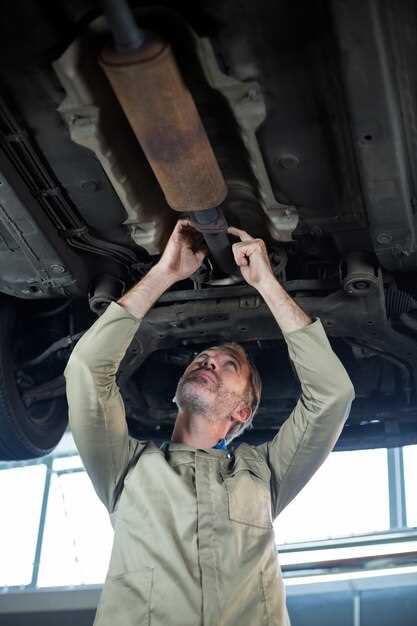
A loud rattling noise from your vehicle’s exhaust system can be both irritating and alarming. It often indicates that something is amiss under the hood, and ignoring the issue could lead to more significant problems down the road. Understanding the common causes of a rattling exhaust is the first step toward resolving the issue and restoring your vehicle’s quiet performance.
In many cases, a rattling exhaust can stem from loose or damaged components. Factors such as rust, physical impact, or wear and tear can contribute to these issues. Identifying the source of the noise is essential for effective troubleshooting. By following this guide, you will be equipped with practical solutions that can help you diagnose the problem and implement the necessary fixes.
This article will outline a series of common strategies for dealing with a rattling exhaust system. From inspecting hangers and clamps to checking for exhaust leaks, we will cover each potential solution in detail. Whether you’re a seasoned mechanic or a novice car owner, these strategies will empower you to address and resolve the rattling noise efficiently and get your vehicle back on the road in optimal condition.
Identifying the Source of the Rattle
Determining the origin of a rattling exhaust is crucial for effective repairs. Begin by using your senses: listen for the rattle while the engine is running, as variations in sound can indicate different issues.
Visual Inspection: Start with a thorough visual examination of the exhaust system. Look for loose connections, cracked pipes, and damaged hangers. Pay close attention to areas where components meet, as these joints are prone to wear and tear.
Check Mountings: Examine the exhaust hangers and brackets. Worn or broken mounts can allow excessive movement, leading to rattling. Ensure that all components are securely fastened, and replace any damaged parts.
Drive Test: Take note of when the rattle occurs. Listen for changes in sound during acceleration, deceleration, or idling. If the rattle intensifies under specific conditions, it may point to a loose shield or internal issue within the exhaust.
Engage Another Person: If possible, ask someone to help. One person can drive the vehicle while the other listens from outside. This method may reveal sounds that are difficult to hear from within the car.
Check for Foreign Objects: Sometimes, other materials can get lodged in the exhaust system, creating rattling noises. Inspect the pipes and muffler for any debris that could cause interference.
Professional Diagnosis: If the source remains elusive, consider consulting a mechanic. A trained professional can conduct a more accurate inspection and utilize specialized tools to pinpoint the problem. Early detection may prevent more costly repairs down the line.
Identifying the source of the rattle involves a careful assessment of various components. Thorough inspection and listening techniques are essential to address the issue effectively.
Checking Exhaust Mounting Points and Hangars
Inspecting the exhaust mounting points and hangars is a crucial step in diagnosing and fixing loud rattling noises. These components play an essential role in securing the exhaust system to the vehicle, ensuring it remains stable while driving. Over time, mounting points can become corroded or damaged, leading to improper alignment and excessive movement.
Begin by visually examining all mounting points along the exhaust system. Look for signs of wear, rust, or fractures in the metal. Specific areas to focus on include the brackets connecting the exhaust pipes to the vehicle frame and any rubber hangars designed to absorb vibration. If you notice any visible damages, it’s likely these components need replacement.
Next, check the integrity of the hangars. Rubber hangars can deteriorate due to heat, road debris, and exposure to the elements. If they are cracked, worn, or missing altogether, they will not provide adequate support for the exhaust system. This can result in excessive movement and the production of rattling sounds. Replacing damaged hangars can significantly reduce noise and improve overall exhaust stability.
It’s also essential to ensure that all bolts and fasteners securing the exhaust system are tight. Loose bolts can cause the exhaust to shift during operation, leading to rattling noises. If you find any loose connections, tighten them using the appropriate tools, following the manufacturer’s specifications for torque settings.
After performing these checks, conduct a test drive to assess whether the rattling persists. If the noise continues, further investigation into other components, such as the exhaust pipes or catalytic converter, may be necessary, but addressing the mounting points and hangars is often a critical first step in resolving exhaust-related issues.
Inspecting for Loose or Damaged Components
When addressing a loud rattling exhaust, the first step is to conduct a thorough inspection for loose or damaged components. Begin by visually examining the exhaust system, including the exhaust pipes, muffler, and connectors. Look for any obvious signs of wear, rust, or physical damage that could contribute to noise.
Check for Loose Connections: Examine all mounting brackets, bolts, and clamps that hold the exhaust system in place. Over time, these components can loosen due to vibrations or corrosion. Use a wrench to tighten any loose connections. If any brackets are missing or broken, they should be replaced promptly.
Inspect for Cracks and Holes: Carefully inspect the exhaust pipes and muffler for cracks or holes. Even small fissures can cause excessive noise and may worsen over time. If cracks are found, it may be possible to repair them with exhaust tape or sealant; however, significant damage may require component replacement.
Evaluate Hangers and Supports: Exhaust hangers are critical in maintaining the proper position of the exhaust system. Check for any damaged or worn rubber hangers that may allow excessive movement of the exhaust components. Replacing these hangers can reduce rattling and secure the system effectively.
Listen for Unusual Noises: With the vehicle running, listen for rattling noises while moving around the exhaust system. Pay attention to any areas that appear to be vibrating more than others. This may indicate a specific location where components are contacting each other or where insulation has degraded.
Assess Heat Shields: Heat shields are designed to protect other components from the heat generated by the exhaust system. Inspect these shields for any loose or damaged sections that may be rattling. Secure or replace any shields as needed to eliminate potential noise sources.
Document any findings during your inspection and prioritize repairs based on the severity of the issues identified. This detailed examination will help ensure that your exhaust system operates quietly and efficiently.
Utilizing Sound Deadening Materials

Sound deadening materials are an effective solution for reducing noise caused by loud rattling exhausts. These materials absorb sound vibrations, preventing them from entering the cabin and creating a quieter driving experience.
Here are some common types of sound deadening materials you can use:
- Mass Loaded Vinyl (MLV): This dense material is often used in automotive applications due to its excellent sound absorption properties. It can be easily applied to various surfaces within the vehicle.
- Foam Mats: Acoustic foam mats can be installed on the floor, doors, and trunk. They are designed to absorb sound, reducing noise levels significantly.
- Rubberized Undercoating: Typically used on the underside of vehicles, rubberized undercoating helps to minimize noise from the road and exhaust, providing a durable barrier.
- Butyl Rubber Sheets: These thick sheets can be adhered to metal surfaces to dampen vibrations and lower noise levels effectively. They are especially useful in the area surrounding the exhaust system.
When applying sound deadening materials, follow these steps:
- Clean the Surface: Ensure surfaces are free from dirt, oil, and rust for optimal adhesion.
- Measure and Cut: Measure the areas to be covered and cut the sound deadening material into appropriate sizes.
- Apply Adhesive (if needed): Some materials come with adhesive backing, while others require a separate adhesive for installation.
- Install the Material: Press the sound deadening material firmly into place, ensuring there are no air bubbles.
- Seal Edges: Use a sealant or tape to secure the edges and prevent peeling over time.
Utilizing sound deadening materials not only alleviates the annoying noises associated with exhaust rattling but also enhances overall driving comfort. Proper installation ensures maximum effectiveness, leading to a quieter and more enjoyable ride.
Replacing Worn or Faulty Parts
When addressing a loud rattling exhaust, it is crucial to identify and replace any worn or faulty components. Over time, exhaust system parts can degrade due to exposure to heat, moisture, and road conditions. Common parts that may require replacement include the exhaust manifold, catalytic converter, muffler, and exhaust pipes.
To begin this process, perform a thorough inspection of the exhaust system. Look for signs of rust, holes, and loose connections, as well as listening for abnormal noises during engine operation. Once the defective parts are identified, proceed with their replacement to restore the exhaust system’s integrity and function.
| Part | Symptoms of Wear | Recommended Action |
|---|---|---|
| Exhaust Manifold | Cracks, leaks, or rust | Replace if damaged |
| Catalytic Converter | Increased emissions, rattling noise | Replace if clogged or damaged |
| Muffler | Excessive noise, visible damage | Replace if corroded or broken |
| Exhaust Pipes | Holes or severe rust | Replace if compromised |
After replacing the faulty components, ensure that all connections are secure and the system is properly aligned. Regular maintenance checks can help identify issues early, preventing more extensive damage and costly repairs in the future. This proactive approach will also contribute to better vehicle performance and compliance with emission standards.
When to Seek Professional Assistance
Identifying the source of a loud rattling exhaust can be challenging. While some minor issues can be resolved with DIY methods, there are specific situations where professional help is essential.
Persistent Noise: If the rattling persists despite your attempts at tightening loose parts or applying temporary fixes, it is a sign that the problem may be more serious. Continuous noise can indicate underlying issues that require expert assessment.
Unfamiliar Components: If you encounter unfamiliar parts or components within your exhaust system, or if the layout seems complex, it is advisable to consult a professional. Experienced mechanics possess the necessary tools and knowledge to address intricate systems properly.
Safety Concerns: If you notice any signs of smoke, burning smells, or unusual vibrations accompanying the exhaust noise, priority must be placed on safety. These symptoms may indicate serious problems that can affect vehicle performance and pose hazards while driving.
Lack of Tools or Experience: If you lack the tools required for a thorough inspection or lack the experience to diagnose exhaust issues accurately, seeking professional assistance is the safest choice. Mistakes during diagnosis can lead to costly repairs later.
Exhaust System Modifications: If your exhaust has been modified or upgraded and started to make noise, professional technicians can ensure that the modifications were completed correctly. Improper modifications can lead to further issues down the line.
In summary, while many rattling exhaust issues can be handled without professional intervention, recognizing when to seek expert help is crucial for ensuring your vehicle’s safety and performance.















